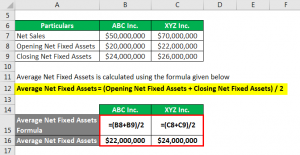

Strategies to Improve Your Fixed Asset Turnover Ratio.Industry Standards for Fixed Asset Turnover Ratio.Interpretation of the Fixed Asset Turnover Ratio Results.Importance of the Fixed Asset Turnover Ratio for Your Business.
Fixed asset turnover interpretation how to#
How to Calculate the Fixed Asset Turnover Ratio.Key Components of Fixed Asset Turnover Ratio.Understanding the Fixed Asset Turnover Ratio.This ratio measures how quickly a company can sell its inventory and is an important metric for assessing its inventory management efficiency. What is the inventory formula in ratio analysis?Īnswer: The inventory formula in ratio analysis calculates the inventory turnover ratio. Accountants use ratios to analyze financial statements and identify areas for improvement, such as reducing costs or increasing revenue. Banks use ratios to assess the creditworthiness of borrowers, while investors use ratios to evaluate the potential returns on investment. Moreover, its use is widespread in many industries, including banking, accounting, and finance. Analysts can make informed decisions about whether to invest in a company, lend it money, or engage in other financial transactions by examining ratios such as the current, debt-to-equity, return on assets, and return on equity. The relevance of the ratio analysis formula lies in its ability to provide a quick and easy way to assess a company’s financial health and identify potential strengths and weaknesses. Balance Sheet Relevance and Use of Ratio Analysis Formula Interest Coverage Ratio = EBITDA / Interest Expense Interest Coverage Ratio = EBITDA / Interest ExpenseĮxample of Ratio Analysis Formula (With Excel Template).Debt to Equity Ratio = Total Debt / Total Equity.The formula of some of the major solvency ratios are: These ratios indicate whether the company can meet its long-term obligations by comparing its debt level with its assets, equity, etc. Equity Turnover Ratio = Sales / Total Equity.Net Fixed Asset Turnover Ratio = Sales / Net Fixed Assets.Asset Turnover Ratio = Sales / Total Assets.Payable Turnover Ratio = COGS / Accounts Payable.Inventory Turnover Ratio = COGS / Inventories.Receivables Turnover Ratio = Sales / Accounts Receivable.The formula of some of the major efficiency ratios are: These ratios indicate how efficiently a company can utilize its available assets or convert its inventories to cash. Return on Total Equity (ROE) = Net Income / Total Equity.Return on Total Asset (ROA) = EBIT / Total Assets.The formula of some of the major profitability ratios are: These ratios demonstrate a company’s efficiency in using its assets to generate profits. Cash Ratio = Cash & Cash Equivalents / Current Liabilities.Quick Ratio = (Cash & Cash Equivalents + Accounts Receivables) / Current Liabilities.Current Ratio = Current Assets / Current Liabilities.The formula of some of the major liquidity ratios are: These ratios indicate the company’s cash level, liquidity position, and capacity to meet its short-term liabilities. We calculate the formula for Ratio Analysis by using the following steps: 1. We broadly categorize the financial ratios used in the ratio analysis technique into the following four major categories: Similarly, ratio analysis helps understand where a company is performing well and where it might need assistance.

Logically you will think that your friend could use some help in Math. It is similar to when you look at your friend’s report card and notice they got an “A” grade in English but a “D” in Math. Using various ratio analysis formulas helps assess the subject company’s financial and operational position. “ Ratio Analysis” refers to the analytical technique wherein various financial ratios are computed based on the financial information available in the company’s annual reports or other public domains. Ratio Analysis Formula (Table of Contents)


 0 kommentar(er)
0 kommentar(er)
